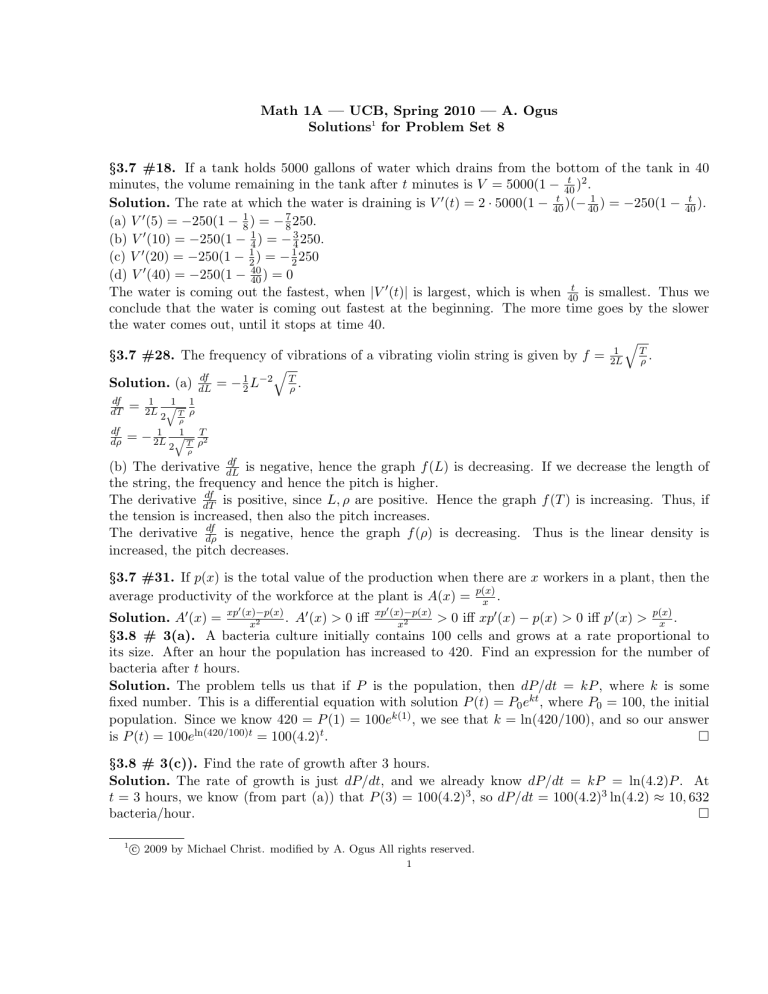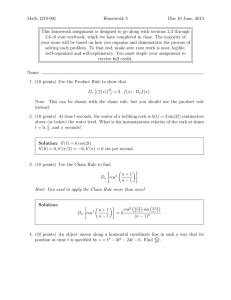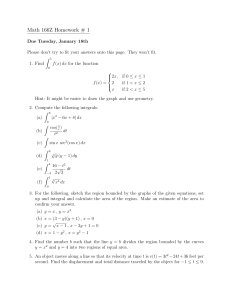
Math 1A — UCB, Spring 2010 — A. Ogus
Solutions1 for Problem Set 8
§3.7 #18. If a tank holds 5000 gallons of water which drains from the bottom of the tank in 40
t 2
minutes, the volume remaining in the tank after t minutes is V = 5000(1 − 40
) .
1
t
t
0
) = −250(1 − 40
).
Solution. The rate at which the water is draining is V (t) = 2 · 5000(1 − 40 )(− 40
1
7
0
(a) V (5) = −250(1 − 8 ) = − 8 250.
(b) V 0 (10) = −250(1 − 41 ) = − 34 250.
(c) V 0 (20) = −250(1 − 12 ) = − 12 250
40
(d) V 0 (40) = −250(1 − 40
)=0
t
is smallest. Thus we
The water is coming out the fastest, when |V 0 (t)| is largest, which is when 40
conclude that the water is coming out fastest at the beginning. The more time goes by the slower
the water comes out, until it stops at time 40.
q
T
1
§3.7 #28. The frequency of vibrations of a vibrating violin string is given by f = 2L
ρ.
q
df
Solution. (a) dL
= − 12 L−2 Tρ .
df
dT
=
df
dρ
1
= − 2L
1 q
1 1
2L 2 T ρ
ρ
1 T
q
2
2 Tρ ρ
df
is negative, hence the graph f (L) is decreasing. If we decrease the length of
(b) The derivative dL
the string, the frequency and hence the pitch is higher.
df
is positive, since L, ρ are positive. Hence the graph f (T ) is increasing. Thus, if
The derivative dT
the tension is increased, then also the pitch increases.
df
is negative, hence the graph f (ρ) is decreasing. Thus is the linear density is
The derivative dρ
increased, the pitch decreases.
§3.7 #31. If p(x) is the total value of the production when there are x workers in a plant, then the
average productivity of the workforce at the plant is A(x) = p(x)
x .
0
0
Solution. A0 (x) = xp (x)−p(x)
. A0 (x) > 0 iff xp (x)−p(x)
> 0 iff xp0 (x) − p(x) > 0 iff p0 (x) > p(x)
x .
x2
x2
§3.8 # 3(a). A bacteria culture initially contains 100 cells and grows at a rate proportional to
its size. After an hour the population has increased to 420. Find an expression for the number of
bacteria after t hours.
Solution. The problem tells us that if P is the population, then dP/dt = kP , where k is some
fixed number. This is a differential equation with solution P (t) = P0 ekt , where P0 = 100, the initial
population. Since we know 420 = P (1) = 100ek(1) , we see that k = ln(420/100), and so our answer
is P (t) = 100eln(420/100)t = 100(4.2)t .
§3.8 # 3(c)). Find the rate of growth after 3 hours.
Solution. The rate of growth is just dP/dt, and we already know dP/dt = kP = ln(4.2)P . At
t = 3 hours, we know (from part (a)) that P (3) = 100(4.2)3 , so dP/dt = 100(4.2)3 ln(4.2) ≈ 10, 632
bacteria/hour.
1
c 2009 by Michael Christ. modified by A. Ogus All rights reserved.
1
§3.8 # 8(a). Bismuth-210 has a half-life of 5.0 days. A sample originally has a mass of 800mg. Find
a formula for the mass remaining after t days.
Solution. We know this is an example of exponential decay, so m(t) = m0 ekt , where m0 = 800
mg, the staring mass, and k is a constant to be determined. Since we know the half-life is 5.0 days,
m(5) = 800e5k = (1/2)m0 = 400, so e5k = 1/2, and 5k = ln(1/2), so k = −(1/5) ln(2). Then
m(t) = 800e−(1/5) ln(2)t = 8002−t/5 .
§3.8 # 8(b). Find the mass remaining after 30 days.
Solution. This is just m(30) = 8002−30/5 = 12.5mg.
§3.8 # 8(c). When is the mass reduced to 1 mg?
Solution. We want to find the time t when m(t) = 1. So, 1 = 8002−t/5 , then log2 (1/800) = −t/5, so
t = −5 log2 (1/800) = 5 log2 (800) ≈ 48.2 days.
§3.8 # 15(a). When a cold drink is taken from a refrigerator, its temperature is 5◦ C. After 25
minutes in a 20◦ C room its temperature has increased to 10◦ C. What is the temperature of the
drunk after 50 minutes?
Solution. The surrounding temperature is 20◦ C, so if T (t) is the temperature of the drink at time
t, let y(t) = T (t) − 20. Then Newton’s Law of Cooling says that y(t) = y0 ekt for some constant k,
where y0 = T (0) − 20 = 5 − 20 = −15. We know −15ek(25) = y(25) = 10 − 20 = −10, so ek(25) = 2/3
and 25k = ln(2/3), so k = (1/25) ln(2/3). Then finally T (t) = y(t) + 20 = −15e(1/25) ln(2/3)t + 20 =
20 − 15(2/3)t/25 . The problem asks for T (50) = 20 − 15(2/3)50/25 = 13.3◦ C.
§3.8 # 19(a). If $3000 is invested at 5% interest, find the value of the investment at the end of 5
years if the interest is compounded (i) annually, (ii) semiannually, (iii) monthly, (iv) weekly, (v) daily,
and (vi) continuously.
Solution. The formula for compounded interest gives the value at time t given by A(t) = A0 (1+r/n)nt
where r is the rate, t is time (in years), and n is the number of times per year it is compounded. Here
A0 = $3000 and r = 0.05, so: (i) A(t) = 3000(1 + 0.05)5 = 3828.84, (ii) A(t) = 3000(1 + 0.05/2)10 =
3840.25, (iii) A(t) = 3000(1 + 0.05/12)60 = 2850.08, (iv) A(t) = 3000(1 + 0.05/52)260 = 3851.61, (v)
A(t) = 3000(1 + 0.05/365)1575 = 3852.01, (vi) A(t) = 3000e(0.05)5 = 3852.08.
§3.9 # 13. A street light is mounted at the top of a 15-ft-tall pole. A man 6 ft tall walks away from
the pole with a speed of 5 ft/s along a straight path. How fast is the tip of his shadow moving when
he is 40 ft from the pole?
Solution. Use similar triangles. Let d be the distance between the man and the pole and let x be
the length of the man’s shadow. Then x/(d + x) = 6/15, so 15x = 6x + 6d and 9x = 6d. Then
x = (2/3)d. The problem wants us to find d(d + x)/dt = d(d)/dx + dx/dt, since this is the speed
of the tip of his shadow. We know dx/dt = (2/3)d(d)/dt and we know d(d)/dt = 5 ft/s, from the
problem. Then d(d + x)/dt = (5/3)d(d)/dt = 25/3 ft/s.
§3.9 # 18(a). A baseball diamond is a square with side 90 ft. A batter hits the ball and runs
toward first base with a speed of 24 ft/s. At what rate is his distance from second base decreasing
when he is halfway to first base?
p
Solution. His distance from second base as a function of t is d(t) = 902 + (90 − 24t)2 by the
Pythagorean theorem. Then d0 (t) = (1/2)(8100 + (90 − 24t)2 )−1/2 (2(90 − 24t))(−24) = −24(90 −
24t)(8100 + (90 − 24t)2 )−1/2 . He is halfway to first base when 24t = 90/2 = 45, so when t = 45/24 =
15/8. Then d0 (15/8) = −10.7 ft/s.
2
§3.9 # 18(b). At what rate is his distance from third base increasing at the same moment?
p
Solution. His distance from second base as a function of t is d(t) = 902 + (24t)2 by the Pythagorean
theorem, again. So d0 (t) = (1/2)(8100 + (24t)2 )−1/2 (2(24t)(24)) and d0 (15/8) = 10.7 ft/s. Geometrically, this makes sense. He should be moving away from third base at the same speed he is moving
toward first base.
§3.9 # 24. A trough is 10 ft long and its ends have the shape of isosceles triangles that are 3 ft
across at the top and have a height of 1 ft. If the trough is being filled with water at a rate of 12
ft3 /min, how fast is the water level rising when the water is 6 inches deep?
Solution. Let V (t) denote the volume of water in the trough at time t. If the height of water at time
t is h(t), then the cross-sectional area of filled water is an isosceles triangle with height h(t), and base
h(t)(3/1) = 3h(t) by similar triangles, so it has area (3/2)h(t)2 . Then V (t) = 10(3/2)h(t)2 = 15h(t)2 .
So V 0 (t) = 30h(t)h0 (t). If t0 is the time when the water is 6 inches deep, h(t0 ) = 1/2, since we measure
al distances in ft. The problem also tells us that V 0 (t0 ) = 12 ft3 /min. Then 12 = 30(1/2)h0 (t0 ), so
h0 (t0 ) = 12/15 ft/min, and this is the rate at which the water level is rising when the water is 6 inches
deep.
§3.9 # 36. Two carts, A and B, are connected by a rope 39 ft long that passes over a pulley P . The
point Q is on the floor 12 ft directly beneath P and between the carts. Cart A is being pulled away
from Q at a speed of 2 ft/s. How fast is cart B moving toward Q at the instant when cart A is 5 ft
from Q?
Solution. Let x(t) be the position of A with respect√to Q and y(t)
p be the position of B, where right
2
2
is positive. The Pythagorean theorem tells us that x + 12 + y 2 + 122 = 39, since the length of
the rope is 39ft. We can differentiate this with respect to t and obtain (1/2)(x2 + 122 )−1/2 (2xx0 ) +
2
2 −1/2 (2yy 0 ) = 0. When cart A is 5 ft from Q, x = −5. and x0 = −2. Furthermore,
(1/2)(y
√ + 12 )
y = 532 ≈ 23.1 by solving for y above, so y 0 = −(1/2)(x2 +122 )−1/2 (2xx0 )/[y(y 2 +122 )−1/2 ] = −0.87
ft/s.
§3.9 # 44. The minute hand on a watch is 8 mm long and the hour hand is 4 mm long. How fast
is the distance between the tips of the hands changing at one o’clock?
Solution. Let θ(t) (t in hours) be the angle of the hour hand (so for 12 AM/PM, θ = π/2 and ψ(t)
be the angle of the minute hand. The coordinates of the tip of the minute hand are (8 cos ψ, 8 sin ψ)
and thep
coordinates of the tip of the hour hand are (4 cos θ, 4 sin θ), so the distance between them
is d = (8 cos ψ − 4 cos θ)2 + (8 sin ψ − 4 sin θ)2 . Then d(d)/dt = [(8 cos ψ − 4 cos θ)2 + (8 sin ψ −
4 sin θ)2 ]−1/2 [2(8 cos ψ − 4 cos θ)(−8 sin ψψ 0 + 4 sin θθ0 ) + 2(8 sin ψ − 4 sin θ)(8 cos ψψ 0 − 4 cos θθ0 ) and
we know at 1 o’clock, θ = π/6, ψ = π/2, θ0 = 2π/12, ψ 0 = 2π/1. We can substitute this in, so
d(d)/dt = 63.2 mm/hr.
§3.10 #2 Find the linearization of f (x) = ln x at a = 1.
Solution. f 0 (x) = 1/x, so f 0 (a) = 1. Since f (a) = 0, the linearization is given by `a (x) = x.
§3.10 #34 The radius of a circular disk is given as 24 cm with a maximum error in measurement of
.2 cm.
(a) Use differentials to estimate th maximum error in the calculated area of the disk.
Solution. The area is given by A = πr2 , and the differential dA = 2πrdr. So if dr = .2, dA =
2π24.2 = 9.6π square centimeters.
(b) The relative error is dA/A which is 2πrdr/πr2 = 2dr/r = 2(.2)/24 = 1/60, or .0167%.
3





